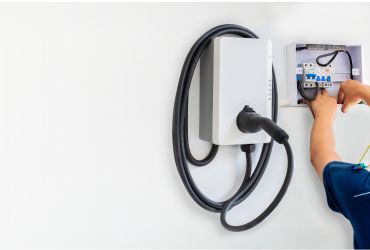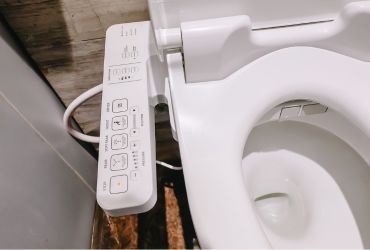What Is The Average Cost Of An EV Charger Installation In Tucson?
The average cost of EV charger installation in Tucson is between $500 and $1,200, including both equipment and labor. Prices can vary based on the installation complexity and electrical upgrades needed.
Many residents want to leave fossil fuel behind, and cars you can plug into a socket like a phone are more appealing than ever. With this shift comes the need for reliable charging options at home. Tucson currently has about 429 EV charging stations, but many more households and businesses plan to install their own chargers for convenience.
If you’re one of them, you’re probably wondering, “What is the average cost of an EV charger installation in Tucson?” The average cost varies because different types of charges have different prices. Then, there are electrical upgrades and labor costs. Let’s break down these costs and help you sort out your budget.
How Installing an EV Charger Benefits You
Access to electric vehicles is more open than ever, and they are a common sight in many Tucson driveways. Drivers also realize the advantages of a charging station on their property.
One benefit of a home EV charger every car owner will appreciate is the convenience.
Just plug the vehicle in and let it charge overnight, and it will be ready in time for your morning commute. This way, you don’t need to plan trips around public charging station locations or wait in line to charge your car. You’ll also know your charging station is always well-maintained and available when you need it. Unlike public chargers, which may be out of order or occupied, your home charger is always accessible and in working condition.
Cost efficiency is another significant advantage. Home charging typically costs less than public stations, especially when electricity rates are lower. The savings you’ll see over time will offset the initial installation cost of your home charger.
It can also increase your property value. As more buyers want homes equipped for EV ownership, having an EV charging station installed and ready will make your property more attractive to potential buyers.
What Influences Installation Costs
Getting a detailed quote for EV charger installation requires more than just calling an installation company and telling them you want one on your property. You must know what type of charger you want and be ready to pay for extra costs like permits and licenses. Preparing in advance will help you avoid unexpected fees and allow the entire process to go smoothly.
Charger Type and Model
The main variable affecting the final cost is the type of EV charger you want. You can install one of the following chargers:
- Level 1 Chargers: This type uses a standard household outlet and typically delivers around 4 to 5 miles of range per hour. They are best suited for overnight charging and have the lowest upfront cost, ranging from $300 to $600, making them popular with most electric vehicle users.
- Level 2 Chargers: They need an outlet of 240 volts and can give you about 25 miles of range per hour. They are ideal for home use, especially if you drive frequently. The installation cost for a Level 2 charger is between $500 and $2,500, depending on the specific model.
- DC Fast Chargers: These chargers are for commercial use and can charge an electric vehicle to 80% in about 30 minutes. They operate at high voltage and have a significant installation cost, generally starting at $10,000 and increasing depending on the electrical capacity and infrastructure.
Installation Complexity
The condition of the existing electrical system and the proximity of the charger to the main electrical panel can add to your expenses. If the distance is considerable, you may need to factor in the cost of additional wiring, incurring additional costs for materials.
You will need an electrical panel upgrade if your current electrical system cannot support the new charger. Those can range from $1,000 to $3,000 based on the existing system’s condition and your home’s electrical demands. If your installation requires trenching to lay new electrical lines, that can add even more to the total cost.
You may also need a few permits, depending on Tucson regulations. Ask the local building department which permits you need to start the installation. These costs can vary widely, so it’s worth investigating this aspect in advance to avoid surprises later.
Labor Costs
The average prices are around $75 to $150 per hour for qualified installers who can handle EV charger installations. The total installation time also influences labor costs, with most installations taking anywhere from 2 to 6 hours. Factors that can extend installation time include:
- The distance to the electrical panel
- The need for additional wiring
- Any modifications required to meet local codes
It’s advisable to consult with multiple contractors to get a competitive rate and hire someone well-versed in EV charger installations.
Permits and Inspection Fees
Local regulations in Tucson require certain permits and inspections for EV charger installations. Depending on your area, a permit can cost $50 to $200. You may also need to pay for an inspection, adding another $100 to $300 to your overall expenses.
To better grasp the specific requirements for your project, consult with your local government or a licensed contractor. Not only will this help you avoid fines, but it will also ensure that your installation is safe and up to code.
Detailed Cost Breakdown
The final number on your installation bill mostly depends on the type of charger you want. Level 2 EV chargers are the better option for households. They charge the vehicles faster charging than Level 1 chargers and are well suited for daily use. The installation costs for a Level 2 charger usually reach $2,500, including the charger itself, labor, and any necessary materials.
A Level 3 charger is often the preferred choice for businesses due to its rapid charging capabilities, allowing multiple vehicles to charge quickly. Installing a Level 3 charger can be more expensive, typically ranging from $15,000 to $40,000. This includes the charger unit, installation labor, and any additional infrastructure. Also, consider the materials and equipment needed, including:
- Circuit breakers
- Wiring
- Mounting hardware
These odd bits and ends can add several hundred dollars to your overall cost.
Incentives and Rebates For EV Charger Installation
In addition to future savings, you can also take advantage of current rebates and incentives for installing an EV charger. Currently, you can claim up to 30% of the installation costs on your federal tax return, making it a practical choice for many homeowners.
Arizona has its own set of programs that offer financial assistance. Some local governments and utilities provide state-specific rebates, so it’s worth checking what your area offers. For instance, Tucson Electric Power (TEP) has incentives for residents who install EV chargers at home. These programs often include rebates that can cover a portion of installation costs or even offer discounts on your electric bill if you charge your vehicle during off-peak hours.
Research and apply for these incentives to get as much savings as possible before proceeding with your installation. Keep the receipts and documentation from your purchases because they are essential for claiming these benefits.
Choosing the Right EV Charger Installer
When selecting an EV charger installer, check if they have the necessary licenses and insurance. Next, read reviews and check their credentials. Look for customer testimonials to gauge their reliability and the quality of their work.
Get quotes from multiple contractors and compare their quotes, services, and timelines, helping you make a more informed decision. Look for transparency in the pricing breakdown, including labor, materials, and additional fees. Check if the contract clearly outlines the scope of work, warranty information, and payment terms.
Feel free to ask questions if something needs to be clarified. Clear communication with your installer can prevent misunderstandings later on. Finally, look for installers who offer ongoing support or maintenance services so if you encounter issues with your EV charger after the installation, you can confidently ask for help.
Find The Best Electricians In Jacksonville
If you’re part of the growing number of people with an electric vehicle, installing an EV charger on your property is the next logical step. How much that charger will cost you depends on its level and any additional work the electricians need to do during the installation. If you’re looking for a company that gives detailed quotes and presents every expense clearly, look no further than Cummings Plumbing.
We will give you a free estimate with no hidden fees. Our electricians can install any type of EV charger you want, and we can guarantee you’ll be more than satisfied with their work. But, if you ever run into any issues, we have a 24/7 emergency service to fix any problem.
Get charged up with our fair pricing – call today and drive easy!
FAQ
What do I have to pay to install a Level 1 EV charger?
Installing a Level 1 EV charger on your property will cost you between $300 and $800. This price includes the charger itself and basic installation fees. Level 1 chargers use standard 120-volt outlets, so installation is less complex and often requires minimal electrical work. However, confirm that your home’s electrical system can handle the load without upgrades, which could increase costs.
Why is a Level 2 EV charger more expensive than a Level 1?
Level 2 EV chargers cost more, ranging from $500 to $1,500, primarily due to their faster charging capabilities and advanced technology. They require a 240-volt outlet, which often needs dedicated electrical work. This installation may involve upgrading your electrical panel or wiring, adding to the overall expense.
Can I get a financial incentive for EV charger installation in Arizona?
Yes, Arizona offers various financial incentives for EV charger installation. You may qualify for federal tax credits, state rebates, or utility company incentives. Check with local utility providers and the Arizona Department of Environmental Quality for specific programs. These incentives help offset installation costs, making setting up your EV charging station more affordable.
Where should I install the EV charger?
Place the EV charger in a location that offers easy access to your vehicle, such as a garage or driveway. Ensure adequate space for installation and that the charger is within reach of your vehicle’s charging port. Also, consider proximity to your electrical panel, as this can reduce installation costs.


